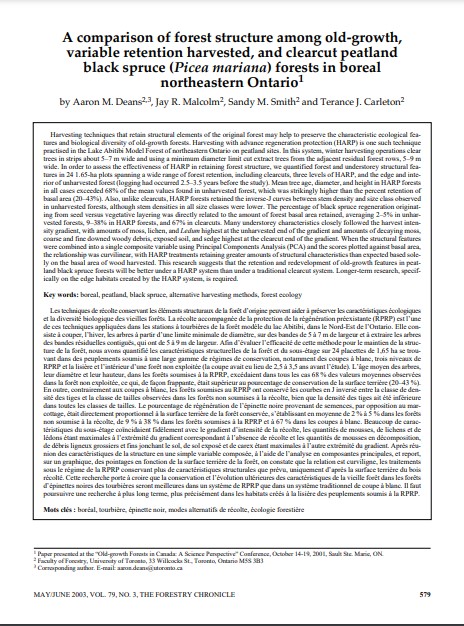A comparison of forest structure among old-growth, variable retention harvested, and clearcut peatland black spruce (Picea mariana) forests in boreal northeastern Ontario
Bosque Modelo:
Lake Abitibi
Temática:
Economía sostenible
Tipo de documento:
Artículo científico
Resumen
Harvesting techniques that retain structural elements of the original forest may help to preserve the characteristic ecological features and biological diversity of old-growth forests. Harvesting with advance regeneration protection (HARP) is one such technique practised in the Lake Abitibi Model Forest of northeastern Ontario on peatland sites. In this system, winter harvesting operations clear trees in strips about 5–7 m wide and using a minimum diameter limit cut extract trees from the adjacent residual forest rows, 5–9 m wide. In order to assess the effectiveness of HARP in retaining forest structure, we quantified forest and understorey structural features in 24 1.65-ha plots spanning a wide range of forest retention, including clearcuts, three levels of HARP, and the edge and interior of unharvested forest (logging had occurred 2.5–3.5 years before the study). Mean tree age, diameter, and height in HARP forests in all cases exceeded 68% of the mean values found in unharvested forest, which was strikingly higher than the percent retention of basal area (20–43%). Also, unlike clearcuts, HARP forests retained the inverse-J curves between stem density and size class observed in unharvested forests, although stem densities in all size classes were lower. The percentage of black spruce regeneration originating from seed versus vegetative layering was directly related to the amount of forest basal area retained, averaging 2–5% in unharvested forests, 9–38% in HARP forests, and 67% in clearcuts. Many understorey characteristics closely followed the harvest intensity gradient, with amounts of moss, lichen, and Ledum highest at the unharvested end of the gradient and amounts of decaying moss, coarse and fine downed woody debris, exposed soil, and sedge highest at the clearcut end of the gradient. When the structural features were combined into a single composite variable using Principal Components Analysis (PCA) and the scores plotted against basal area, the relationship was curvilinear, with HARP treatments retaining greater amounts of structural characteristics than expected based solely on the basal area of wood harvested. This research suggests that the retention and redevelopment of old-growth features in peatland black spruce forests will be better under a HARP system than under a traditional clearcut system. Longer-term research, specifically on the edge habitats created by the HARP system, is required.
Información Bibliográfica
Autor:
Deans, AM, JR Malcolm, SM Smith and TJ Carleton.
Revista:
Forestry Chronicle
Año:
2003
N°:
3
País :
Canadá
Páginas:
579 - 589
Volumen:
79
Idioma:
Ingles
Palabras claves
boreal, peatland, black spruce, alternative harvesting methods, forest ecology





